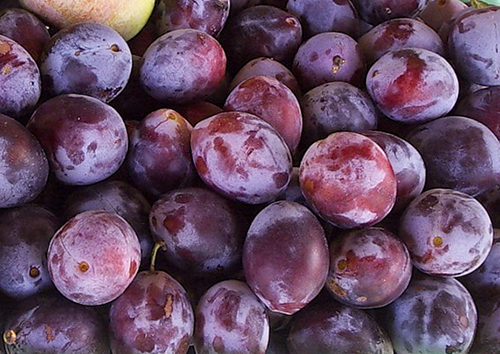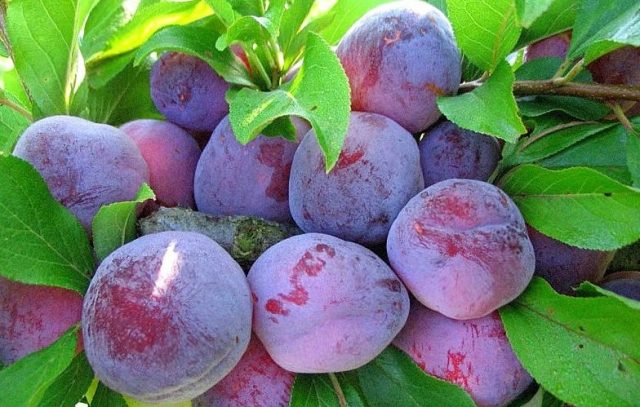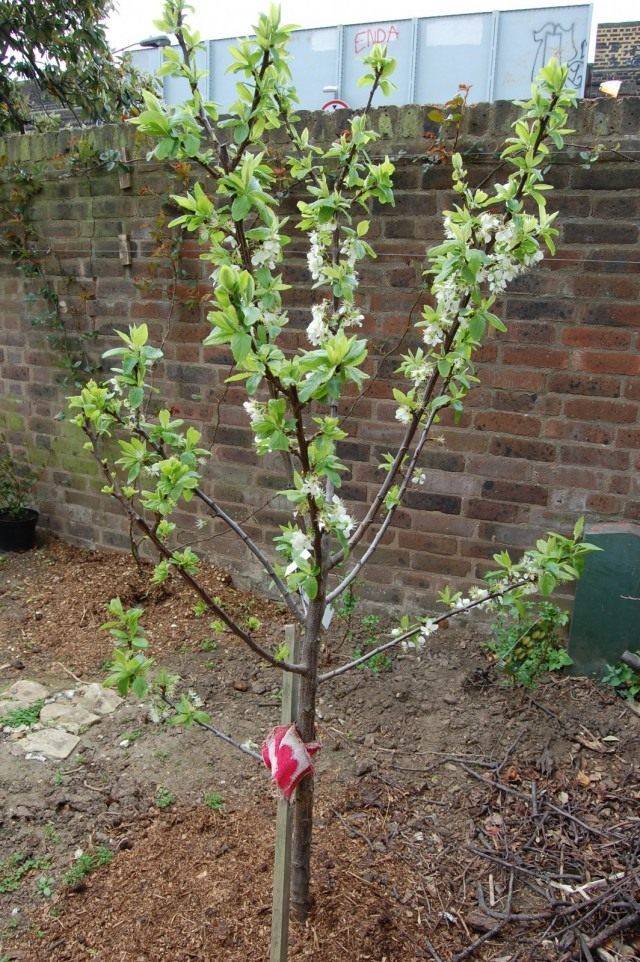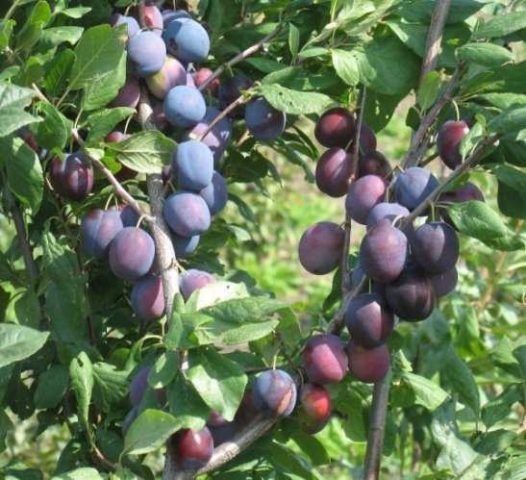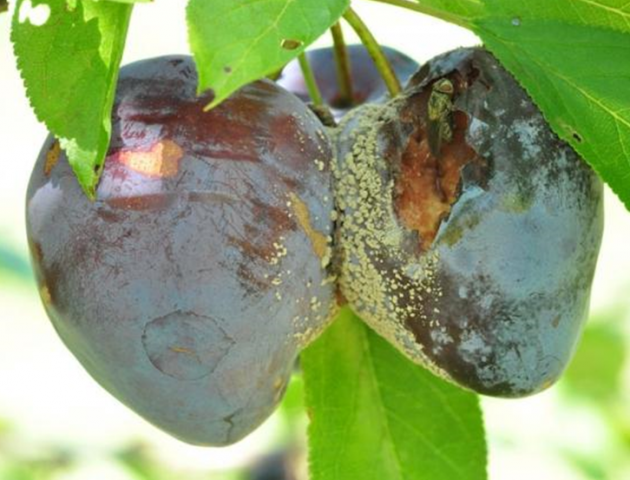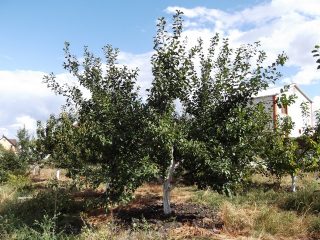Content
Plum Bogatyrskaya, like all varieties of plums, contains many useful elements, has a positive effect on the human body. This culture belongs to unpretentious plants. Even with a minimum of maintenance, you can get a decent harvest.
Breeding history
The variety was obtained at the Research Institute of the city of Nizhne-Volzhsk by crossing the Gypsy and Vengerka plums by the breeders Korneevs. The variety is included in the State Register for the Volgograd Region.
Description of Bogatyrskaya plum
The description of the Bogatyrskaya plum variety includes basic information about it. The tree is of medium growth, has a spreading crown of medium thickening. The shape of the crown is round. The trunk and skeletal branches of the variety are gray. The branches are located at an acute angle to the trunk.
Leaves are medium in size, ovate with a sharp end. The edges of the leaf are jagged. The surface of the leaves is dark green, the reverse side is much lighter.
The plum of this variety blooms with white flowers, they are collected in inflorescences of 2-3 pieces. The fruits of the Bogatyrskaya plum are in the form of an ellipse, large, 40 g each, sometimes 50-60 g. They have a dense skin. The color of the fruits of the variety is dark purple, almost black, with a bluish bloom.
The stone is not large, 8% of the weight of the berry, it is not very easy to separate from the pulp. The very pulp of the plum variety is dense, greenish, juicy. The taste is sweet and sour, slightly honey.
Variety characteristics
Below are the characteristics of the Bogatyrskaya plum variety.
Drought resistance, frost resistance
Requires watering, although it easily tolerates slight drought. It tolerates low temperatures easily, does not require shelter for the winter. The frost resistance of the Bogatyrskaya plum variety is quite high.
Plum pollinators Bogatyrskaya
This plum variety is self-pollinated, no pollinators are required for it, which is one of the advantages. If a plant of a different variety is planted next to the Bogatyrskaya plum, this will increase the yield of both varieties. Bogatyrskaya blooms in late May, the fruits are formed and ripen late. They fill up by the end of August.
Productivity and fruiting
The tree bears a rich harvest, which happens almost every year. The yield of the variety increases with the growth of the tree. A young plant will yield 50 kg of fruit. Adult plums will yield up to 80 kg. Fruits begin to appear 5 years after the seedlings are planted in a permanent place. The tree bears fruit with proper care for 20-30 years.
Scope of berries
Fresh fruits are tasty and healthy. For use in winter, blanks are made as jam, jam or compote. Tasty plum tincture turns out.
Disease and pest resistance
Plum variety Bogatyrskaya rarely gets sick. Only a wet, cold summer can provoke fungal diseases. Harmful insects appear on the plant, but do not bring noticeable harm to it.
Advantages and disadvantages
Advantages:
- Large tasty fruits.
- Fruit crack resistance.
- Winter hardiness of the variety.
- Productivity.
Sometimes the abundance of fruits leads to their crushing, flexible branches can bend and break under their weight. This is a disadvantage of the variety.
Planting and caring for the Bogatyrskaya plum
The cultivation of the Bogatyrskaya plum variety does not differ from working with other types of this fruit crop.
Recommended timing
This crop is planted in spring. The best time to plant plums is early April, when the ground has already thawed, severe frosts have gone, and the tree is still dormant.
Choosing the right place
The place where the plum is grown should be well lit. Tall trees should not be planted near this crop. So that the trees are well lit all day, they are planted in a row, positioned from north to south. Plum of this variety can be planted on steep slopes, southern or eastern.
Plums are planted in high areas so that wet, swampy places where cold fog collects do not destroy the plant. The soil should not be heavy. Sandy loam fertilized soils will be the best for plums.
What crops can and cannot be planted nearby
Undesirable neighbors for plums are walnut trees. For the central regions, these are walnuts and hazel. Do not place birch, linden and poplar next to plums.
From fruit trees, close-planted apple and pear will be unpleasant for plums, but in the same garden they will get along quite well. But the bushes of black currant have a beneficial effect on the plant. It is best not to plant anything closer than 3 meters, giving the plum room to grow.
Selection and preparation of planting material
The bogatyrsky plum sapling is chosen as an annual one. It should have a developed root lobe. The aboveground part of the seedling is a thin twig grafted onto the stock. If it is purchased with an open root system, it should be soaked in Kornevin or potassium permanganate for disinfection. Seedlings purchased in pots are removed from the container, shaken off the ground and examined the roots, then planted.
Landing algorithm
For spring planting, planting pits are prepared in the fall. The pit diameter is 0.8 m, the depth is 0.4 m. During the winter, the soil in the pit becomes looser, and the roots penetrate it better. A distance of 5.5 meters is maintained between the pits.
A pile of earth fertilized with mineral and organic compounds is poured into the pit. A seedling is placed on a mound of earth, the roots are spread along its slope. The tree is positioned so that the root collar is 5 cm above the ground. In this case, it should not be confused with the grafting site, it is located above the root collar.
The roots are moistened with water, covered with soil, slightly compacted, then watered again. This will require at least a bucket of water.
Plum follow-up care
Correct and timely pruning of the Bogatyrsky plum will prolong its fruiting period, increase the yield and save the tree from diseases.
The first pruning is done when planting a tree. Its trunk is cut to 1/3 of the height. So the crown will form faster. Pruning is done every spring. The first is a sanitary operation to remove damaged shoots.
The growth of branches is monitored. If it gets small, you need to prune the branch back to more mature wood. The branches lowered to the ground are cut off. At a time, no more than ¼ of the volume of the branches is cut off.
Young trees are prepared for wintering. They are wrapped in thick cloth, lutrasil or straw. Tied with a rope. This will protect the plum from frost and small rodents. The near-stem space is covered with dry grass, peat or any mulching material. Mature trees of this variety do not insulate.
A year after planting the seedlings, the tree will need top dressing. You can scatter dry complex fertilizer over the snow, in the summer it is watered with infusion of bird droppings. Adult trees are fertilized by spreading humus in tree trunks in autumn.
Young trees are watered, monitoring the state of the near-trunk soil. Adult plants, especially if grass grows around them, need not be watered, moisture will remain under the lawn layer.
Collection, processing and storage of crops
They start collecting plums, when they are not yet fully ripe, 6 days before full ripeness. In this case, they can be transported and not damaged during removal. The fruits are easily removed from the tree. Mechanical harvesting of Bogatyrsky plum is possible.
At home, they cook jam from plums, make compotes. In the food industry, this berry is used in canned form, and alcoholic beverages are made from it.
Diseases and pests, methods of control and prevention
Diseases of culture | Description | How to get rid of |
Hole spot
| Brown spots appear on the leaves, then holes in their place. Shoots crack, gum flows from them | Dig the soil around. The diseased parts are cut out and burned. Spray trees with a 3% Bordeaux mixture |
Fruit rot | Appears when the fruit ripens, like a gray spot on the berries. Spread by wind, damaging other fruits | Collecting rotten fruits. The tree is treated with drugs "Topsin", "Horus", "Azocene" |
Pests | Description of the pest | Ways to destroy them |
Hawthorn | A butterfly eating the green parts of the tree. | Collecting and destroying butterfly caterpillars |
Yellow plum sawfly | Eats the fruits of the plum. A worm is visible inside the berry | Adults are shaken off to the ground. Before flowering, they are sprayed with the preparations "Inta-Vir", "Fufanon" |
Plum aphid | Cover the back of the leaves, after which they curl and dry out | They use folk recipes, sprinkling with an infusion of garlic, ammonia, and dust with tobacco dust. Biological preparation "Fitoverm" is used |
Conclusion
Plum Bogatyrskaya is well suited for summer cottages. It is tasty, unpretentious and fruitful. 2-3 trees are enough, and the family will be provided with useful fruits for the whole summer and winter.
